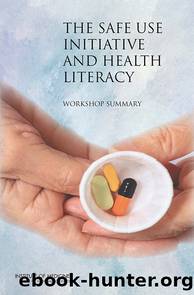The Safe Use Initiative and Health Literacy: Workshop Summary by Institute of Medicine of the National Academies

Author:Institute of Medicine of the National Academies
Language: eng
Format: epub
Tags: Health and Medicine : Public Health and Prevention. Health and Medicine : Policy, Reviews and Evaluations
Publisher: NATIONAL ACADEMIES PRESS
Published: 2010-11-27T00:00:00+00:00
An additional concern raised by Wendy Mettger of Mettger Communications, relates to adult learners who donât understand terms such as acetaminophen, ibuprofen, or even active ingredient. She asked if those terms have been tested with consumers. Parker agreed that active ingredient is a difficult term for patients. She has an upcoming study showing that consumers think that acetaminophen and antihistamine are the same thing. Research has not focused on this area. She hopes to call attention to the problem of knowing what a product is. If there is agreement that to safely use a medication, the patient needs to know what it is before he or she takes it, then knowing what a product is comes to the forefront every time safe use of a medication is addressed. Bernard Dreyer added that a lot is known about what patients with low literacy need so they can understand a label. They need pronunciation guides and simple definitions. The problem is that the real estate on all labels is very minimal. But it is the only thing that is really going to help low literacy patients understand what is on the label.
Dreyer then asked what impact USPâs General Chapters have. Are they law of the land? Does the FDA play a role? Long responded that the USP sets voluntary standards, and now the USP will work with the National Association of Boards of Pharmacy to adopt the standard. The USP will also talk with the FDA about what role it might play to get the standards taken up.
One participant asked whether patients are involved in product and standard development. Bullman used the example of the NCPIE-developed program called âMaximizing Your Role as a Teen Influencer: What You Can Do To Help Teens Prevent Prescription Drug Abuse.â The content was derived from data from the Substance Abuse and Mental Health Services Administration (SAMHSA), the National Institute on Drug Abuse (NIDA) and other published research. NCPIE brought together 15 organizations that were all working on the same issue but had not worked together before.2 Representatives of school health, school psychologists, parent-teacher associations, Partnership for a Drug-Free America, and American Academy of Pediatrics, for example, came together. Messaging was focus tested in two states. Now that it is launched, three states are doing an assessment of up to 500 people who have been exposed to the workshop, asking questions before, after, then at 3-month intervals. It is a fairly extensive program.
2
See http://www.talkaboutrx.org/maximizing_role.jsp.
Download
This site does not store any files on its server. We only index and link to content provided by other sites. Please contact the content providers to delete copyright contents if any and email us, we'll remove relevant links or contents immediately.
Application of a Novel Technique for Clinical Evaluation of Nitric Oxide-Induced Free Radical Reactions in ICU Patients by Unknown(693)
Rosenâs Emergency Medicine Concepts and Clinical Practice by Ron Walls; Robert Hockberger; Marianne Gausche-Hill; Timothy B. Erickson; Susan R. Wilcox(571)
Oxidative damage to surfactant protein D in pulmonary diseases by Vitality Starosta1 & Matthias Griese1†(406)
Social Science Perspectives on Global Public Health by Vincent La Placa & Julia Morgan(372)
Constructing Canine Consent; Conceptualising and Adopting a Consent-focused Relationship with Dogs by ERIN JONES(329)
Organic Chemistry: An Acid - Base Approach by MICHAEL SMITH(299)
ADVANCED EMERGENCY CARE AND TRANSPORTATION OF THE SICK AND INJURED by Unknown(270)
Saunders Nursing Drug Handbook 2024 - E-Book by Unknown(262)
Davis's Comprehensive Manual of Laboratory and Diagnostic Tests with Nursing Implications by Unknown(245)
Diagnostic and Statistical Manual of Mental Disorders, Fifth Edition, Text Revision (DSM-5-TR(tm)) by Unknown(245)
Socio-Life Science and the COVID-19 Outbreak : Public Health and Public Policy by Makoto Yano; Fumihiko Matsuda; Anavaj Sakuntabhai; Shigeru Hirota(244)
Human Microanatomy; Cell Tissue and Organ Histology with Celebrity Medical Histories by Stephen A. Stricker(242)
Berne and Levy Physiology E-Book by Unknown(234)
Replacing the Dead by Mie Nakachi;(229)
Handbook of Skin Disease Management by Jiyad Zainab;Flohr Carsten; & Carsten Flohr(228)
Access to Medicines and Vaccines in the South : Coherence of Rules and Policies Applied by the European Union Commission by Stephen Kingah(224)
The Pocket Guide to Sensorimotor Psychotherapy in Context (Norton Series on Interpersonal Neurobiology) by Pat Ogden(218)
Deep Learning and Medical Applications by Unknown(217)
Advances and Technical Standards in Neurosurgery by Unknown(213)
